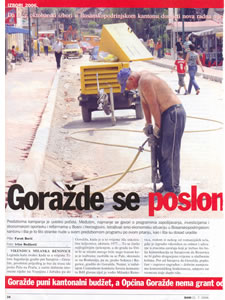Voters, Not Politicians, Set Agenda
Turnout for Bosnia and Herzegovina’s national elections in October 2006 was expected to be low. Voters were tired of hearing the same partisan rhetoric from candidates accustomed to exploiting ethnic and political divisions, but they didn’t expect anything different. Not until the independent media stepped in.
With support from USAID, 30 TV, radio, and print outlets produced more than 650 hard-hitting reports based on issues people said they cared about. The issues were identified through public opinion polling — the first time research was used this way in Bosnia and Herzegovina. Over a four-month period, journalists looked at fresh research results every two weeks and worked with the USAID team to develop stories that delved deeper into problems affecting everyday life.
Among the topics addressed were health care, education, the environment, opportunities for people with disabilities, and the role of women in public life.
 |
| A story in the popular weekly DANI talks about a candidate’s plans to create
employment and promote refugee return, two issues identified by voters as
important to them |
Media partners established rigorous reporting criteria. Each story had to have at least four elements: extensive research by the reporter, a candidate’s ideas on the topic at hand, an interview with an independent expert, and the citizen’s point of view. An experienced journalist from the project team provided feedback on how to improve content and presentation. For some journalists, this was the first time they had ever worked on a single story for several weeks and in great depth.
“You helped us discover how much we know and what we’re capable of doing,” one radio producer said.
Media coverage helped to shift the election dialogue from partisan rhetoric to everyday reality. Candidates were put on the spot by citizens demanding solutions to specific problems. Most candidates rose to the challenge, but occasionally, politicians were at a loss for words or even failed to show up for an interview or panel discussion. Their performance gave voters new insight into their ability to do the job.
Turnout was higher than expected at 55 percent of 2.7 million eligible voters, with some 400,000 new voters registered and more young people casting their votes this time around. Media partners said they believed better coverage was one factor in drawing more people to the polls.
Back to Top ^ |


